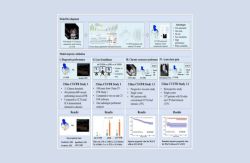Findings from a large study show that migraine is a risk marker for coronary events and cardiovascular death. This is especially true for women with migraine as they had a 50 percent higher risk for developing major cardiovascular disease. The findings have been published in BMJ.
Risk was elevated for angina/coronary revascularizations, stroke, and CV mortality. lead author Dr Tobias Kurth (Charité–Universitätsmedizin, Berlin, Germany says that the findings are quite robust and clinically relevant as this was a large study and a different age group.
The link between stroke and migraine has been established previously but prior studies showed conflicting results. This new study involved 115,541 women aged 25 to 42 years at enrollment in the Nurses' Health Study II, of whom 17,531 had migraine at baseline and another 6389 who were diagnosed during follow-up from 1989 through June 2011.
Findings show that women with migraine were more likely to have hypertension, elevated cholesterol, family history of MI before age 60, and body-mass index of >30 kg/m2—all factors adjusted for in the multivariable analysis.
In an accompanying editorial[2], Dr Rebecca Burch (Harvard Medical School, Boston, MA) and Dr Melissa Rayhill (State University of New York at Buffalo, NY) write, "It is time to add migraine to the list of early life medical conditions that are markers for later life cardiovascular risk."
Although the magnitude of the risk is small at the individual patient level, it is still important at a population level because migraine is so prevalent, especially in certain US minorities and lower socioeconomic groups, which commonly have more cardiovascular risk factors.
Because all participants were female and information was not collected on migraine with aura, the study cannot answer whether CVD risk is elevated in men or whether, as with stroke, this risk is confined to the subgroup with aura, although "both things seem likely," they note.
Kurth agreed the lack of information on aura is a clear limitation of the study but added, "For us it was still amazing to see that we see the flag for any migraine. If it's true that it's driven by migraine with aura, of course the estimates are higher for this group and less for migraine without aura."
Driving forces
Several biological mechanisms linked to migraine have also been linked to higher CVD risk such as increased thrombogenic susceptibility, shared genetic markers, and systemic inflammation. Kurth said there's likely not one mechanism but a combination of a genetic disposition plus other factors that need to be present before these events actually occur.
There is evidence, however, that the risk increase for stroke is different from that for CVD. In 2008, the researchers reported[4]that for stroke women with migraine and aura had a fairly healthy CV risk profile, but for MI the opposite was true and they had an unhealthy CV risk profile. "But the numbers we are playing with are fairly low, so I have to be careful in making causal implications."
Burch and Rayhill write that it is important to understand how the vascular risk attributable to migraine interacts with other risk factors. "A special worry is whether the combined effects of two risk factors may result in multiplicative, rather than additive, risks."
This is particularly relevant for phase 3 migraine trials under way examining antibodies to calcitonin-gene–related peptide (CGRP) or its receptors, as animal studies suggest the risk of vascular events increases during long-term CGRP blockade.
To Treat or Not
The editorialists write that the results raise many questions regarding treatment: "Do treatments that decrease the frequency or severity of aura or headache reduce later-life vascular risks? Should patients with migraine be treated with statins or aspirin?"
Despite "their intuitive appeal," however, they urge caution in assuming that these interventions will benefit patients with migraine. An exploratory analysis from the Women's Health Initiative, for example, showed that women with migraine with aura who took aspirin actually had an increased risk of MI.
"At present, migraine is probably best thought of as a situation in which the medical urge to 'do something' (beyond currently recommended assessments for cardiac risk and advocating a healthy lifestyle) should be resisted."
Kurth said none of the studies they've published would indicate that treating migraine would reduce the risk of CV events but that there is a paucity of evidence in this area and in migraine research in general.
For now, women with migraine can talk with their clinicians about how to modify or treat CVD risk factors such as hypertension. They can also demand more research.
"We cannot leave millions of women with migraine and by the way, also men, alone and say, 'We have this increased risk, but sorry we cannot give you any answers because we have no data.' This is unacceptable."
Kurth reports receiving investigator-initiated research funding from the French National Research Agency, US National Institutes of Health, and the University of Bordeaux and honoraria from the BMJand Cephalalgia for editorial services. Disclosures for the coauthors are listed in the article. Burch reports working with Kurth in an editorial capacity at the BMJ in the past.























